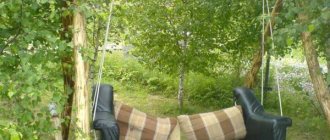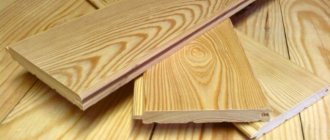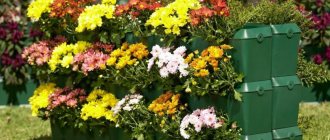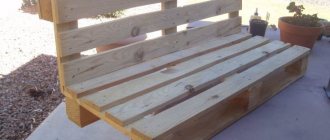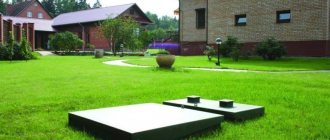- Flower beds made of wooden boxes Light flair of Provence
- Beauty in a wicker basket
The term “flowerbed” refers to a flower bed raised above the lawn in the form of a closed figure, often a geometric shape with clearly defined contours. To decorate them, many amateur gardeners use various construction waste and household items. Creating a flowerbed with your own hands from scrap materials is a fascinating activity that provides the opportunity to use waste items, show your imagination and, sometimes, create original design compositions that will delight your guests and neighbors.
The beauty of plants is emphasized by finishing with stone, brick, boards and other materials
Flowerbeds can be:
- regular planting - their placement, arrangement, flower assortment are carefully planned, observing the laws of geometry, taking into account the uniformity of plant height, simultaneous flowering and other parameters;
- irregular - such flower beds are renewed every year, their location is changed if they are planted only with annuals.
At your summer cottage you can perfectly combine both types. But most gardeners prefer the second option due to its simplicity and naturalness, choosing for planting frost-resistant perennials and favorite annual flowers that will bloom, gradually replacing each other, throughout the season.
About planting patterns
Following the rules of good landscape design, which most often coincide with the currently fashionable direction of Feng Shui, it is necessary not so much to transform nature as to adapt to its characteristics. Achieving natural harmony and organically incorporating existing buildings and decorative elements into our design, with our own hands we build a saving refuge from the everyday hustle and bustle.
“After all, every garden is a landscape, and it is unique, it is modest or rich - I admire it equally, gardeners should be artists!” This is how the French poet Jacques Delisle outlined the creative task.
In the coming long winter evenings, it makes sense to properly prepare for creating your garden and flower beds. Study existing literature, the experience of ordinary gardeners. Plan on paper where and what flower beds at your dacha you will be able to plant with your own hands next spring.
Do I need to process the boards?
To make flower beds and flower beds with your own hands, you must use only materials that have undergone special processing. Considering that wooden structures are outdoors all year round, they are constantly exposed to adverse environmental factors. If you ignore the preliminary preparation of the boards, then there is a high probability that the following will appear on them:
- putrefactive processes;
- wood-boring pests;
- swelling/shrinkage;
- cracks
Among the folk remedies for wood processing, it is worth noting the following:
- copper sulfate (50-100 g per 10 liters of water);
- bitumen mastic (heated to a liquid state);
- a mixture of sunflower oil (1 l) and propolis (300 g);
- heat treatment with a blowtorch;
- used machine oil;
- resin from coniferous trees.
It is worth using oil antiseptics to treat wooden flower beds in regions with high levels of humidity.
To effectively protect flower beds and flower beds made of wood, made by yourself, it is recommended to use combined antiseptics. They contain coloring pigments, which allows not only to prevent rotting and destruction of the material, but also to achieve a highly decorative design.
Types of flower beds of regular composition
Before you start work, you need to decide what type of flower beds we want to create with our own hands at the dacha:
- Ordinary amateur gardeners in open areas arrange simple flowerbeds with a horizontal layout flush with the surface or slightly raised in the center so that the water drains better. They are planted with flowers of the same type, or different varieties. Or plants of 2-3 types;
- along the walls of the house or paths, ridges are arranged - narrow, long stripes with low-growing plants along the edges and tall plants in the center;
- lawns or other plantings can be bordered with borders of ornamental plants (cineraria, sedum) or low-growing ones of the same species (alissum, lobelia);
- plantings of large flowers or ornamental shrubs (dahlia, amaranth, peony) are called tapeworms;
- from the already mentioned elements you can create parterres - compositional combinations of lawns, ridges, borders, alpine slides, etc.;
- on rocky areas that are difficult to adapt to anything else, rock gardens (rockeries) and alpine slides are laid out;
- mixborders are an elegant society of colorfully combined flowers, picking up the baton from each other for continuous flowering.
Tires are banned?!
Waste tires belong to hazard class III-IV. They emit a number of harmful substances, including carcinogens, heavy metals, toxic odor; are highly flammable.
Their decomposition period is 130 years. Waste of this class cannot be stored and disposed of independently. This should be done by the relevant organizations with collection points.
What the law says
Since July of this year, a lot of articles have appeared on the Internet about the introduction of a ban on growing flowers in car tires and making sculptures from them. Not a single author provides specific references to the new wording of the changes made to the legislative framework.
Federal Law No. 141-FZ dated June 17, 2019 amended the Code of the Russian Federation on Administrative Offences.
Article 8.2 of the Code of Administrative Offenses of the Russian Federation since 2022 includes tougher penalties
In particular, paragraph 1 of Article 8.2 of the Code of Administrative Offenses of the Russian Federation now provides for the imposition of fines for non-compliance with requirements in the field of environmental protection when collecting, accumulating, transporting, processing, recycling or neutralizing production and consumption waste. The size of the fine depends on the category of violators:
- citizens – 1-2 thousand rubles;
- officials - 10-30 thousand rubles;
- persons carrying out entrepreneurial activities without forming a legal entity - 30-50 thousand rubles;
- legal entities – 100-250 thousand rubles.
It turns out that they can be fined not for violating the rules of landscaping, but for storing and burying (disposing) tires on a land plot. It turns out that if rubber swan flower beds are located near an apartment building, the management company will be held accountable, and if on a summer cottage, the owner?!
The authorities of several Russian cities (Sochi, Rostov-on-Don, Irkutsk) had previously banned the use of tires in landscaping, enshrining this in law.
A matter of taste
One can argue endlessly about how beautiful flower beds made from tires and figures made from them are. But since the courtyards of apartment buildings are still replete with elements of such housing office art, it means there are many adherents.
In most cases, tires look like an element of kitsch with a catchy shape and primitive content
In my opinion, this is tasteless, especially when in a limited area there are a large number of bright wheels, the notorious swans, hippos, cartoon characters, pigs from plastic bottles, mushrooms from old enamel bowls, plastic buckets, basins dug into the ground... The feeling, that you are walking past a landfill. Although the same tires, decorated with bright annuals, look quite appropriate and symbolic on the territory of a car park, car company, or driving school.
I honestly admit that for 7 years I myself planted flowers in two large, apparently tractor tires, located on the lawn between the two entrances of an apartment building. I didn’t dare to liquidate them: they stood before me. And I understood why. The soil under the lawn is poor; to set up a good flower garden, you would need to bring a carload of fertile soil and stones, and this requires serious money and a lot of physical labor. And the effort spent on beauty would be a pity due to the unfortunately low culture among the population: all the asters planted in the first year were picked for a bouquet before September 1...
To give a more aesthetic appearance, tires are painted, cut into shapes, reshaped, and supplemented with original parts.
At first, I didn’t paint the balloons at all, until I saw from the balcony how a neighbor with a brush encroached on them: “I renewed my flowerbeds, the paint was still there, so it’s up to you!” I had to paint over the provocative bright yellow color (I managed to smear it on), purchasing a matte, lighter, eye-pleasing shade. I did not cover it completely, but only the inner edging and some protruding parts of the tires. I planted marigolds in them (medium-growing varieties in the center, low-growing varieties along the edge), cineraria, and lobelia. In principle, two such flower beds, decorated in a simple and identical style, looked good on a regularly mowed lawn.
What to pay attention to
When you have decided where you would like to start arranging your garden, find out everything you can:
- about the composition and acidity of the soil on the site;
- how much the area is open to winds;
- What is the humidity and light level at the intended planting site?
This will determine how your plants will develop in the future. The key to success when designing any garden is to be able to take advantage of the natural conditions with the help of the right plants and their combinations for maximum aesthetic effect. A border growing in the shade can look no less impressive than a bright flowerbed in a shining sunny place if you skillfully play with the variety of shapes and shades of leaves. Decorating a flowerbed with contrasting dark and light colors will significantly enhance the effect.
Creating a simple discount
- Let's draw a diagram, for example, circles of plants or triangles.
- Let's select plants. Let's start with unpretentious plants that can withstand drought. Let these be seedlings of viola and cochia broom.
- Let's build the ridge itself from scrap materials. You can build your own flowerbeds from scrap materials from what was left over during the construction of a house - long boards, scraps of siding, etc. Let's lay out a perimeter of them, burying them ten centimeters into the ground.
- If the garden is located in a climate zone where there is a lot of rain and melt water, pour drainage at the bottom of the ridge: broken bricks, crushed stone.
- We add soil (a loose mixture of fertile soil and compost), on which we mark geometric shapes using a hoe.
- We plant the prepared seedlings as follows: closer to the place that is more open for viewing, we plant a viola of four colors of different shades. We plant kochia seedlings in the background.
The ridge turned out to be slightly raised, it will be convenient to pull out emerging weeds.
It can be built in a place where the soil is not suitable for vegetable seedlings.
How to decorate a flowerbed so that it looks original and unique?
Let's use a little creativity. You can build a fence around the ridge we created. To do this, we will drive stakes of the same height on four sides of our perimeter. If the flowerbed is long, then we drive in a few more support stakes. We weave dry branches between them. You can decorate the top with clay pots, artificial sunflowers, etc.
Note!
Perennial flower beds: TOP-200 photos of the best options and new designs. Instructions and diagram for decorating a flowerbed with your own hands
How to prune tomatoes so that they bear fruit - step-by-step instructions for correct pruning of tomatoes for a better harvest
Currants have pale leaves, what to feed them - a review of the most effective techniques from a gardener
Viola, popularly called "Pansy", comes from the violet family. It has been popular since the times when ancient tribes in Europe decorated themselves and their homes with these bright flowers.
Viola is winter-hardy, shade-tolerant, but does not suffer much from drought. Seedlings are grown from the end of February. Planting in the ground in a permanent place is carried out depending on the climate, in April or May. Having previously prepared the holes at a distance of ten centimeters from each other, plant them, trample the soil and water them.
We chose a sunny, slightly elevated area for our flowerbed near the house, which means it should be good for “Pansies”.
Kochia is an annual plant that loves sunny places. These are fluffy openwork bushes of emerald color in the summer, and by autumn the outfit becomes purple. They will beautifully highlight our delicate violets.
Plants for alpine slides
Those who take alpine slides seriously will be able to grow something special in their garden. It’s better to start with easy-to-care but beautiful plants like saxifrage or sedum. A flower bed made of stones will decorate a corner of any garden.
Flowerbed made of wooden blocks
To decorate the garden and local area, flowerbeds made of wooden blocks are often used. It is both stylish and quite affordable. From this natural material you can make a tub or a large box. A multi-tiered pyramid-type structure will look great in landscape design. The algorithm for performing the work is the same as when using boards. The only thing is that you need to choose metal pins to connect the elements.
Wooden blocks do not have to be installed at one level; a multi-level fencing will look unusual
An original solution would be to equip the flower garden with a fence made of wooden blocks. Each part is dug into the ground, ensuring their stability. The shape of the flowerbed can be absolutely any, interesting design - in the form of a month, a star, a cloud.
Compositions with stones
Depending on the circumstances, stones can be regular or irregular in shape. In a classic garden, round or square stones or slabs will look great. Natural stones look even better in other parts of the garden, in flower beds.
Note!
Flowers for a flower bed - 140 photos of the most beautiful and unpretentious flower options for a summer cottage
Fast-growing climbing plants for the fence and garden - a review of the best types (120 photos). Instructions: how to select and plant climbing plants
How to arrange a front garden: tips, ideas, practical advice. Planting beautiful flowers in front of the house (instructions + photos)
Separately located stones have a place everywhere, not only on the lawn or border. But it is necessary to secure them well so that they are safe.
Rock garden
Based on the principle of balance between Yin and Yang, you can create harmonious compositions from stones. A rock garden is not just a mound of earth with stones scattered over it. The design must be strictly verified, with good drainage. To do this, the slide is made from a mixture of loam, sandstone and stones, laid in the form of layers of exposed rock. Plants are planted on ledges and in vertical crevices between stones. Unoccupied areas of soil are sprinkled with gravel or small stones.
Dare in your creative flight, create beautiful flower beds in your dacha. After all, the truth is old:
“Ever since man acquired the ability to plow,
He felt the urge to decorate the yard and house.
(J. Delisle)
Varieties
There is no generally accepted classification of flower beds, but there are several names that are used most often.
Border
This flower bed is used as a decorative fence. Its width usually does not exceed sixty centimeters, and matching flowers and shrubs are used as decoration; both longitudinal and transverse symmetry are preserved.
Flower garden-border at the dacha
Mixborder
In structure and size, this flower garden is similar to the “border” type. Most often it is installed at the junction of the path and walls. This flower bed has no transverse symmetry; it seems to separate this joint.
Mixborder flower garden at the dacha
Parterre
It is also called an ornamental flower garden. The flowers on it are arranged in a certain order and form a pattern, generally large in area. Used as decoration.
Graphic flower garden parterre at the dacha
Rabatka
This is a variation of the parterre flower garden, but with a more defined size. It is generally accepted that its width varies from half a meter to three meters, and its length is three times or more than its width. If the ridge flower bed is located near the wall, then the plants are planted in ascending height. And if you can inspect it from all sides, then the tallest plants and shrubs are planted in the center, and from them the lower ones are located at levels.
Flower bed scheme discount
Roccary
This is a flower garden in which special attention is paid to additional elements. The basis of the composition in it are large stones, which can lie either evenly and structured, or in a chaotic, natural order. Together with them in the flower garden there are small plants: creeping, climbing and heather shrubs. And also many others that are suitable in general style and whose growth is possible in such a flower garden.
Picturesque flower garden rockery
